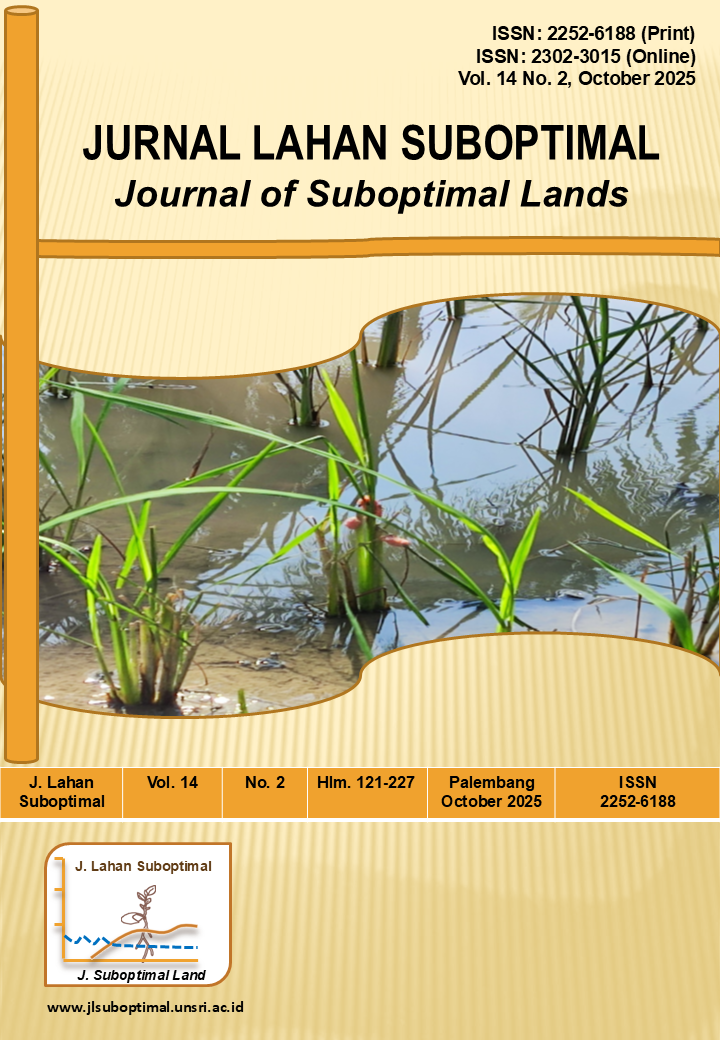Growth and yield response of lettuce (Lactuca sativa L.) planted floatingly to optimization of NPK compound fertilizer
DOI:
https://doi.org/10.36706/jlso.14.2.2025.741Keywords:
floating agriculture, lettuce, NPK fertilizer, urbanitation, sustainableAbstract
Urban agriculture had expanded rapidly in response to growing population pressures and climate change, especially in densely populated areas of developed countries. South Sumatra holds significant potential for developing floating agricultural systems. This study aimed to evaluate the effects of compound NPK fertilizer and a floating planting system on lettuce growth. A Randomized Block Design (RBD) with four treatment levels was used. Each treatment was repeated 3 times, resulting in 12 treatment units. In the treatment of NPK compound fertilizer doses, P0 = Control, P1 = 1.12 g NPK compound/polybag, P2 = 2.24 g NPK compound/polybag, P3 = 3.36 g NPK compound/polybag. The observation results were analyzed using analysis of variance and the DMRT 5% test. The parameters observed include plant height, number of leaves, fresh weight of the plant, fresh weight of the roots, dry weight of the roots, root length, leaf greenness level, leaf area, and canopy area. Based on the research findings, the application of compound NPK fertilizer at a rate of 2.24 g/polybag (P2) resulted in the most favorable growth and yield performance of floating lettuce, as it consistently produced the highest mean values across all observed parameters. However, the calculated optimum dosage was 2.05 g/polybag. This rate is therefore recommended as the optimal application dose for subsequent studies.
References
Addai, P., Mensah, A. K., Sekyi-Annan, E., & Adjei, E. O. (2023). Biochar, compost and/or NPK fertilizer affect the uptake of potentially toxic elements and promote the yield of lettuce grown in an abandoned gold mine tailing. Journal of Trace Elements and Minerals, 4(August 2022), 100066, 1‒12. https://doi.org/10.1016/j.jtemin.2023.100066
Alvarado-Camarillo, D., Valdez-Aguilar, L. A., González-Fuentes, J. A., Rascón-Alvarado, E., & Peña-Ramos, F. M. (2020). Response of hydroponic lettuce to aeration, nitrate and potassium in the nutrient solution. Acta Agriculturae Scandinavica Section B: Soil and Plant Science, 70(4), 341–348. https://doi.org/10.1080/09064710.2020.1730430
Bañón, C., & Raspall, F. (2022). 3D printing floating modular farms from Plastic Waste. Materials Today: Proceedings, 70, 560–566. https://doi.org/10.1016/j.matpr.2022.09.591
Burgess, A. J., Pranggono, R., Escribà-Gelonch, M., & Hessel, V. (2024). Biofortification for space farming: Maximising nutrients using lettuce as a model plant. Future Foods, 9(December2023), 100317. 1‒12. https://doi.org/10.1016/j.fufo.2024.100317
Chatterjee, A., Ghosh, P., Winkler, B., Vijayaragavan, V., Debnath, S., Cichocki, J., Trenkner, M., Vanicela, B., Riethmueller, C., Walz, M., Chandra, S., & Pal, H. (2025). Scientia horticulturae demystifying the integration of hydroponics cultivation system reinforcing bioeconomy and sustainable agricultural growth. Scientia Horticulturae, 341(January), 113973, 1‒12. https://doi.org/10.1016/j.scienta.2025.113973
Clerino, P., & Fargue-Lelièvre, A. (2020). Formalizing objectives and criteria for urban agriculture sustainability with a participatory approach. Sustainability (Switzerland), 12(18), 1‒16. https://doi.org/10.3390/su12187503
Dehghani, Z., Haghighi, M., & mozafarian, M. (2025). Comparison of the effect of Rosa damascena compost, animal manure, and chemical fertilizer on growth and biochemical characteristics of mint plant. Biomass and Bioenergy, 194(January), 1‒11. https://doi.org/10.1016/j.biombioe.2025.107622
Dolatmand-Shahri, N., Modarres-Sanavy, S. A. M., Mirjalili, M. H., Mokhtassi-Bidgoli, A. (2025). Phosphorus fertilizer and arbuscular mycorrhizal fungi application improves bitter melon fruit yield and some phytochemical compounds under irrigation deficit stress. Current Plant Biology. 42, 1‒13. https://doi.org/10.1016/j.cpb.2025.100446
Ekawati, R., & Saputri, L. H. (2020). The effect of different shade levels on growth characteristics and biomass of dayak onion plants (Eleutherine palmifolia L. Merr). Jurnal Hortikultura Indonesia, 11(3), 221–230. http://dx.doi.org/10.29244/jhi.11.3.221-230
Filip, D., Macocinschi, D., Nica, S. L., Condurache, B., Stoleru, E., Mihaela, D., Bargan, A., & Zaltariov, M. (2023). A meta-analysis of 30 years in China and micro-district experiments shows organic fertilizer quantification combined with chemical fertilizer reduction enhances rice yield on saline-alkali land. International Journal of Biological Macromolecules, 32 (2), 259‒272. https://doi.org/10.1016/j.rsci.2025.01.004
FAOSTAT. (2025). Food and Agriculture Organization of the United Nations. [Online]. Available: https://www.fao.org/faostat/en/#data/QCL, (accesed on 18 January 2025).
Gil-Ortiz, R., Naranjo, M. Á., Ruiz-Navarro, A., Atares, S., García, C., Zotarelli, L., Bautista, A. S., & Vicente, O. (2020). Enhanced agronomic efficiency using a new controlled-released, polymeric-coated nitrogen fertilizer in rice. Plants, 9(9), 1–17. https://doi.org/10.3390/plants9091183
Gumisiriza, M. S., Ndakidemi, P. A., Nampijja, Z., & Mbega, E. R. (2023). Soilless urban gardening as a post covid-19 food security salvage technology: A study on the physiognomic response of lettuce to hydroponics in Uganda. Scientific African, 20 (2023), 1‒9. https://doi.org/10.1016/j.sciaf.2023.e01643
Hassan, M. N., Mekkawy, S. A., Mahdy, M., Salem, K. F. M., & Tawfik, E. (2021). Recent molecular and breeding strategies in lettuce (Lactuca spp.). Genetic Resources and Crop Evolution, 68(8), 3055–3079. https://doi.org/10.1007/s10722-021-01246-w
Hefner, M., Gebremikael, M. T., & Kristensen, H. L. (2024). Soil microbial activity improved while intensifying vegetable production by use of plant-based fertilisers, cover crops and reduced tillage. Pedobiologia-Journal of Soil Ecology, 102 (2024), 1–7. https://doi.org/10.1016/j.pedobi.2023.150926
Kiba, T., & Krapp, A. (2016). Plant nitrogen acquisition under low availability: Regulation of uptake and root architecture. Plant and
Cell Physiology, 57(4), 707–714. https://doi.org/10.1093/pcp/pcw052
Lazaratou, C. V., Triantaphyllidou, I. E., Spyridonos, I., Pantelidis, I., Kakogiannis, G., Vayenas, D. V., & Papoulis, D. (2021). NO3−-N removal from water using raw and modified fibrous clay minerals and their potential application as nitrogen fertilizers in hydroponic lettuce cultivations. Environmental Technology and Innovation, 24 (2021), 1–17. https://doi.org/10.1016/j.eti.2021.102021
Liu, X., Chen, C., Zhang, Y., & Tong, Y. (2025). Scientia Horticulturae Effects of nutrient solution recycling on water and nutrient consumption patterns and lettuce growth. Scientia Horticulturae, 341(January), 1–12. https://doi.org/10.1016/j.scienta.2025.113976
Martínez-Moreno, A., Carmona, J., Martínez, V., Garcia-Sánchez, F., Mestre, T. C., Navarro-Pérez, V., & Cámara-Zapata, J. M. (2024). Reducing nitrate accumulation through the management of nutrient solution in a floating system lettuce (Lactuca sativa, L.). Scientia Horticulturae, 336(April), 1–13. https://doi.org/10.1016/j.scienta.2024.113377
Maulidiya, T., & Edy, S. N. (2022). The effect of water volume and frequency on the microenvironment, growth and yield of garlic Plants (Allium sativum). PLANTROPICA: Journal of Agricultural Science, 7(1), 17–27. https://doi.org/10.21776/ub.jpt.2022.007.1.3
Nabayi, A., Teh, C. B. S., Tan, A. K. Z., Tan, N. P., & Beke, D. (2023). Combined benefits of fermented washed rice water and NPK mineral fertilizer on plant growth and soil fertility over three field planting cycles. Heliyon, 9(9), 1‒14. https://doi.org/10.1016/j.heliyon.2023.e20213
Roba, T. B. (2018). Review on: The Effect of Mixing Organic and Inorganic Fertilizer on Productivity and Soil Fertility. OALib, 05(06), 1–11. https://doi.org/10.4236/oalib.1104618
Salama, D. M., Khater, M. A., & Abd El-Aziz, M. E. (2024). The influence of potassium nanoparticles as a foliar fertilizer on onion growth, production, chemical content, and DNA fingerprint. Heliyon, 10(11), 1–15. https://doi.org/10.1016/j.heliyon.2024.e31635
Serna, M., Hernández, F., Coll, F., & Amorós, A. (2012). Brassinosteroid analogues effect on yield and quality parameters of field-grown lettuce (Lactuca sativa L.). Scientia Horticulturae, 143, 29–37. https://doi.org/10.1016/j.scienta.2012.05.019
Sica, P., & Magid, J. (2024). Placement of acidified digestate solid fraction as an efficient starter phosphorus fertilizer for horticulture crops. Scientia Horticulturae, 328(August 2023), 11–14. https://doi.org/10.1016/j.scienta.2024.112961
Sharma, N., Acharya, S., Kumar, K., Singh, N., & Chaurasia, O. P. (2018). Hydroponics as an advanced technique for vegetable production: An overview. Journal of Soil and Water Conservation, 17(4), 364‒371. https://doi.org/10.5958/2455-7145.2018.00056.5
Simon, F. (2018). The world’s first floating farm making waves in Rotterdam, 2018. [Online]. Available: https://www.bbc.com/news/business-45130010
Temegne, N. C., Liégui, G. S., Sandeu, K. D. B., Fomekong, K. M., Mbadia, K. N. S., Eyenga, M. S. M., & Youmbi, E. (2024). Manure-based composts influence soil quality after lettuce (Lactuca sativa L.) production. Journal of the Saudi Society of Agricultural Sciences. 1‒11. https://doi.org/10.1016/j.jssas.2024.08.005
Tesfa, T., Asres, D., & Woreta, H. (2018). Lettuce (Lactuca sativa L.) yield and yield components as affected by mulching at Teda, Centeral Gondar, Ethiopia. International Journal of Scientific Research and Management (IJSRM), 6(09), 190–194. https://doi.org/10.18535/ijsrm/v6i9.ah01
Downloads
Published
How to Cite
Issue
Section
License
Copyright (c) 2025 Delly Salsabila Amanda, Rahmat Hidayatulah, Susilawati Susilawati

This work is licensed under a Creative Commons Attribution-NonCommercial-ShareAlike 4.0 International License.













